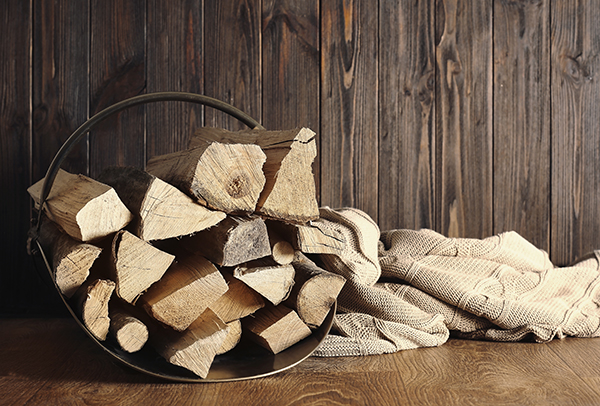
Whether you have a fireplace or wood stove, firewood is essential to your home heating and enjoyment. You may have been building fires for decades or you may have recently installed a wood-burning system. Maybe you are considering installing a fireplace or just purchased a home with a fireplace and are new to the world of firewood. Whatever the case, there are firewood safety tips that can help you store and burn your firewood safely, efficiently, and effectively.
Choosing Firewood
Firewood safety starts with choosing your firewood. The type of wood you use is important. Different types of wood have different burning properties. Hardwoods such as beech, oak, black walnut, apple, sugar maple, and hickory have high heat value, burn the longest and thus, are the most efficient. Due to their dense nature, these hardwoods, may take longer to properly dry out and become seasoned.
Cottonwood, though common in this area, is soft and burns fast with a low heat value. Pine is another wood to avoid. Pine may be easy to find and thus less expensive, but it is resinous and more likely to spark. It also has a low heat value and burns very quickly. Never burn Christmas trees in your fireplace or wood stove.
Another firewood safety tip is to choose local wood. Transporting firewood from another region increases the likelihood of introducing a new species of insect or disease to your area which can have a lasting, negative effect on your local environment. For example, the emerald ash borer - thought to have been introduced to the United States via wooden packing materials from China – was first discovered in 2002 in the Detroit area. To date, the emerald ash borer has destroyed 40 million ash trees in Michigan alone according to the Arbor Day Foundation. That’s over 2 million trees a year! Using only local firewood can reduce or slow the spread of such destructive invaders.
Storing Firewood
Proper storage is a key factor in having good firewood. It’s possible to have well-seasoned firewood that is ruined due to poor storage conditions. Therefore, keeping your firewood properly protected and stored is important. When firewood is constantly exposed to the elements, it will likely reabsorb water which can cause rotting. If possible, store firewood off the ground to eliminate exposure to excess moisture.
Seasoned firewood – wood that is left to dry for at least six months, or a “season” - burns best with minimal smoke. Since all wood is nearly 50% water, it needs time to dry out before it will burn well. Cutting firewood to shorter lengths is an important part of the evaporation process. Wood is essentially a network of tiny tube-like vessels that transport water from the roots through the trunk and out to the leaves through its branches.
Firewood that is cut into shorter sections allows water to escape from these “tubes” where it is stored. Left uncut, trees can store this water for years – causing it to rot. Think of the difference in trying to dry out a 50-foot garden hose vs. cutting 50 1-foot sections of the same hose. (Of course, the hose would be destroyed, but you get the idea!) Stack wood in a dry place, or cover the top only of the pile to protect it from rain and snow. Covering the sides of the pile can block airflow and trap moisture in, causing decay.
Elevate your stack of wood at least a few inches off the ground to allow the entire stack to dry. A wood rack, pallets or even poles as the base for your woodpile will allow enough ventilation to prevent wood from rotting in the pile.
If you purchased already-seasoned wood, you’ll just need to focus on keeping it dry. If it turns out that your wood is pretty green but you choose to burn it before it’s properly seasoned you will need to have your chimney inspected more often. Burning green wood is a sure-fire way to quickly build up creosote in your chimney.
One way to assure your wood is properly seasoned is to cut or purchase your wood in the spring, store it properly throughout the summer, and begin to burn it in the fall. With proper seasoning and storage, firewood can last three or even four years. Keep in mind that to insects, such as termites, a woodpile is a five-star hotel. So, consider only bringing in logs as you intend to burn them – or you may bring unwanted insects into your home. That’s a firewood safety tip that can keep your home pest-free!
Burning Firewood
Some firewood safety tips seem like common sense. However, what may seem like the most obvious tips can sometimes be overlooked, many times because we become so comfortable we can unintentionally become lax – and that’s when accidents can occur.
Be sure to keep a fireplace screen up to prevent sparks from igniting nearby carpet, wood or other flammables. However, even with a fireplace screen, never leave an active fire unattended. It only takes a spark to cause a fire and, in less than two minutes, a fire can become life-threatening.
Know what the warning signs are for chimney trouble and pay attention. Watch for excessive smoke, puff-back, or signs of a fire up in the chimney. If your fireplace hasn’t been cleaned or inspected in the last year, don’t burn in it. It could have creosote buildup or other debris inside.
Never Use Anything Besides Firewood
Though it is tempting to start fires with objects that aren’t designed to be burned, avoiding this pitfall is one of the final firewood safety tips. Items such as construction scraps, landscaping ties or other treated woods can let off toxic fumes or leave toxic debris. Trash is another thing that should never be burned – you never know what chemicals could be released. These chemicals could be toxic to you, your family and even your pets. They could also build up in your chimney.
Finally, don’t attempt to jump start your fires with accelerants like gasoline. It’s never safe when used indoors. Not only can they cause unexpected bursts of flames and flare-ups, they can cause the temperature of the fire to burn hotter than your chimney was designed to withstand. These hotter temperatures can increase the risk of chimney fires.
Your fireplace or wood stove can be a wonderful source of home heating, and a focal point for entertainment. When you keep firewood safety and usage tips in mind and care for your fireplace and chimney properly with regular inspections, you will have a safe, warm, cozy home for years to come!
Keep Your Michigan or Ohio Chimney Safe – Call Doctor Flue!
We can inspect and repair your fireplace, stove or chimney to fix any problem! Contact us today to schedule an inspection to help keep your home safe and your fireplace ready for winter.
Call Us: 1-800-438-3583
Email Us: office@drflue.com
Office Hours: Mon-Fri: 8am-4pm
Connect with Doctor Flue on Social Media

